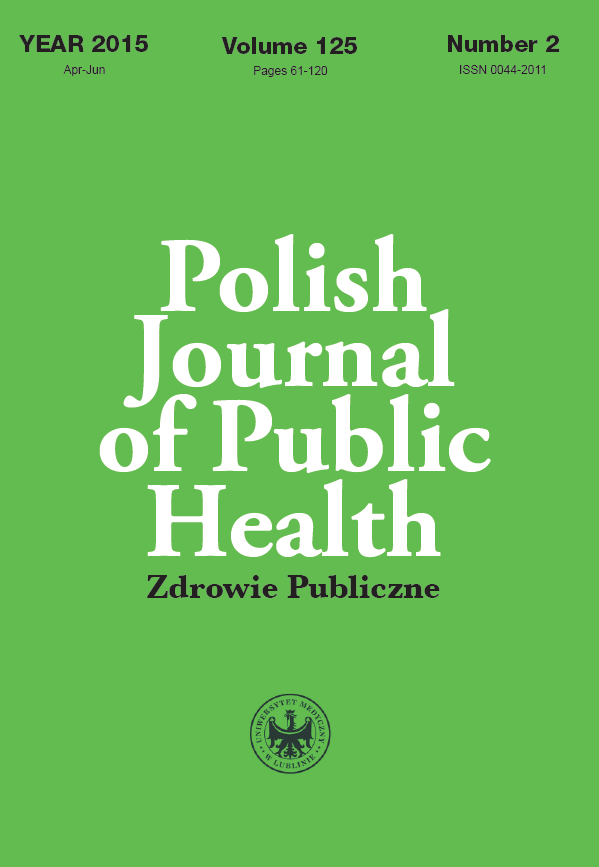Rubella outbreak in Poland in 2013 – an analysis of surveillance data at the national and province level
DOI:
https://doi.org/10.1515/pjph-2015-0026Keywords:
rubella, epidemiological situation, PolandAbstract
Introduction. Poland is a member of the WHO European Region where a complete eradication of measles and rubella is planned to be finished by 2015. Poland accounted for 99% of all reported rubella cases in 27 EU/EEA countries in 2013. It is a good time to evaluate whether the established Polish vaccination strategy was sufficient to reach the goal of rubella elimination in the near future.
Aim. The aim of this study was to analyze the epidemiology of rubella in Poland when the disease outbreak took place
in 2013, to determine the reasons of that situation and to find the solution for future rubella elimination strategies.
Material and methods. To analyze the epidemiology of rubella in Poland during the disease outbreak in 2013 the authors used rubella surveillance data collected by the Provincial and National Notifiable Disease Reporting System in 2004-2013.
The information at the provincial level derived from one of the 16 provinces (Malopolska). The data on MMR vaccination coverage in 2003-2012 derived from the National Surveillance System. The percentages of rubella cases and vaccine coverage between Poland with Malopolska province were compared.
Results. The outbreak started in late 2012 and continued through 2013, when 38548 rubella cases (incidence rate 100.1/100 000) were notified. Geographically, rubella cases were reported from the entire country, with the highest incidence rate in Malopolska province (254.9/100 000). Only 5 cases from Malopolska and 120 in whole country were laboratory confirmed, the remaining 99.7% were reported solely on the basis of clinical signs. The vaccination coverage was not sufficient to protect the population against rubella outbreak in Poland, especially among adolescents and young adult males.
Conclusions. The strengthening of routine immunization program and implementation of some additional vaccination campaigns in young adults as well as laboratory confirmation of all suspected cases are the challenges that will have to be met to eliminate rubella in Poland.
References
1. World Health Organization. Eliminating measles and rubella. Framework for the verification process in the WHO European Region. World Health Organization Regional Office for Europe, Copenhagen, Denmark; 2012. [http://www.euro.who.int/__data/assets/pdf_file/0005/156776/e96153-Eng-final-version.pdf]
2. Pan American Health Organization. Plan of Action of the documentation and verification of measles, rubella, and congenital rubella syndrome elimination in the region of the Americas. Washington DC: Pan Ameri¬can Health Organization; 2011.
3. Castillo-Solórzano C, Marsigli C, Bravo-Alcántara P, et al. Elimination of rubella and congenital rubella syndrome in the Americas. J Infect Dis. 2011;204:S571-S578.
4. Pasławska A, Mrozek-Budzyn D. Is measles elimination possible in WHO European Region up to 2015? Przegl Epidemiol. 2013;67:451-4.
5. National Institute of Public Health – National Institute of Hygiene. Vaccinations in Poland in 2012. [http://www.pzh.gov.pl/oldpage/epimeld/2012/Sz_2012.pdf]
6. Mrozek-Budzyn D. The evolution of Polish Immunization Schedule during the last 10 years. Przegl Epidemiol. 2012;66:107-12.
7. European Commission. Commission decision of 19 March 2002 lay¬ing down case definitions for reporting communicable diseases to the Community network under Decision No 2119/98/EC of the European Parliament and of the Council. Official Journal of the European Union. Luxembourg: Publications Office of the European Union. Communities. 3.4.2002:L 86/44. [http://eur-lex.europa.eu/ LexUriServ/LexUriServ.do?uri=OJ:L:2002:086:0044:0062:EN:PDF]
8. National Institute of Public Health – National Institute of Hygiene. Infectious diseases and poisoning in Poland 2004-2013.[http://www.pzh.gov.pl/]
9. World Health Organization. Rubella vaccines: WHO position paper. WHO Weekly epidemiological report. 2011;86:301-16. [http://www.who.int/wer/2011/wer8629.pdf 7]
10. National Institute of Public Health – National Institute of Hygiene. Za¬chorowania na wybrane choroby zakaźne w Polsce od 1 stycznia do 15 sierpnia 2014 r. oraz w porównywalnym okresie 2013 r. Zakład Epi¬demiologii NIZP-PZH. [http://www.pzh.gov.pl/oldpage/epimeld/2014/INF_14_08A.pdf]
11. European Center for Disease Control. Surveillance report. Measles and rubella monitoring. Stockholm: ECDC; 2014.
12. Janta D, Stanescu A, Lupulescu E, et al. Ongoing rubella outbreak among adolescents in Salaj, Romania, September 2011-January 2012. Euro Surveill. 2012;17(7):1-4
13. Centers for Disease Control. Nationwide rubella epidemic – Japan, 2013. MMWR. 2013;62:457-62.
14. Hopkins DR. Disease eradication. N Engl J Med. 2013;368:54-63.
15. World Health Organization. Global measles and rubella strategic plan: 2012-2020. Switzerland: World Health Organization; 2012. [http://www.measlesrubellainitiative.org/wp-content/uploads/2013/06/Mea-sles-Rubella-Strategic-Plan.pdf].
16. World Health Organization. Eliminating measles and rubella. Frame¬work for the verification process in the WHO European Region. Geneva: World Health Organization 2012. [http://www.euro.who.int/__data/as¬sets/pdf_file/0005/156776/e96153-Eng-final-version.pdf].
17. Casiday R. Uncertainty, decision-making and trust: lessons from the MMR controversy. Community Pract. 2006;79:354-7.
18. Brown KF, Kroll JS, Hudson MJ, et al. Factors underlying parental decisions about combination childhood vaccinations including MMR: a systematic review. Vaccine. 2010;28:4235-48.
19. Usonis V, Anca I, André F, et al. Rubella revisited: where are we on the road to disease elimination in Central Europe? Vaccine. 2011;29:9141-7.
20. Edmunds WJ, van de Heijden OG, Eerola M, Gay NJ. Modelling rubella in Eur Epidemiol Infect. 2000;125:617-34.
21. Vandermeulen C, Roelants M, Theeten H, et al. Vaccination coverage and sociodemographic determinants of measles-mumps-rubella vacci¬nation in three different age groups. Eur J Pediatr. 2008;167:1161-8.
22. McGreevy D. Risks and benefits of the single versus the triple MMR vaccine: how can health professionals reassure parents? J R Soc Promot Health. 2005;125:84-6.
Downloads
Published
Issue
Section
License
Copyright (c) 2015 Polish Journal of Public Health

This work is licensed under a Creative Commons Attribution-NonCommercial-NoDerivatives 3.0 Unported License.


